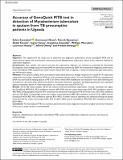Accuracy of GenoQuick MTB test in detection of Mycobacterium tuberculosis in sputum from TB presumptive patients in Uganda
Abstract
Objective The objective of the study was to determine the diagnostic performance of the GenoQuick MTB test on heated sputum against the conventional Lowenstein–Jensen Mycobacterium tuberculosis culture as the reference method for tuberculosis diagnosis. Introduction Fast, reliable, and easy-to-use tests for tuberculosis diagnosis are essential to achieving the Sustainable Development Goal of diagnosing and treating 90% of tuberculosis patients by 2030. We evaluated the diagnostic performance of the GenoQuick MTB, a polymerase chain reaction–lateral flow test, in Uganda, a resource-constrained, high tuberculosis- and HIV-burden setting. Methods Fresh sputum samples from presumptive tuberculosis patients at Mulago Hospital were tested for M. tuberculosis using smear microscopy, GenoQuick MTB test, and Lowenstein–Jensen culture. For the GenoQuick MTB test, mycobacterial DNA was extracted by heating sputum at 95°C for 30 min while DNA amplification and detection were done following the manufacturer’s protocol (Hain Lifescience, Nehren, Germany). Sensitivity, specificity, and kappa agreements were calculated against Lowenstein–Jensen M. tuberculosis culture as a reference test using STATA V12. Results Of the 86 tested samples, 30.2% had culture-confirmed pulmonary tuberculosis. Overall, sensitivity was higher for GenoQuick MTB (81%, 95% confidence interval: 60%−93%) than for smear microscopy (69%, 95% confidence interval: 48%−86%). Among people living with HIV, sensitivity was identical for GenoQuick MTB and smear tests (75%, 95% confidence interval: 42%−95%). Contrastingly, smear had a higher overall specificity (98%, 95% confidence interval: 91%−100%) than for GenoQuick MTB (92%, 95% confidence interval: 81%−97%). A similar trend of specificity was observed among the people living with HIV for smear microscopy (100%, 95% CI: 87%−100%) and for GenoQuick MTB (96%, 95% confidence interval: 81%−100%). Conclusion The GenoQuick MTB test could be a potential tuberculosis diagnostic test given its higher sensitivity. Evaluation of this test in larger studies is recommended.
Citation
Kaswabuli , S , Musisi , E , Byanyima , P , Sessolo , A , Sanyu , I , Zawedde , J , Worodria , W , Huang , L , Okeng , A & Bwanga , F 2022 , ' Accuracy of GenoQuick MTB test in detection of Mycobacterium tuberculosis in sputum from TB presumptive patients in Uganda ' , SAGE Open Medicine , vol. 10 . https://doi.org/10.1177/20503121221116861
Publication
SAGE Open Medicine
Status
Peer reviewed
ISSN
2050-3121Type
Journal article
Description
Funding: The author(s) disclosed receipt of the following financial support for the research, authorship, and/or publication of this article: MIND study was funded by National Institutes of Health (NIH) (NIH K24 HL087713, R01 HL090335, and R01 HL128156). MBN Clinical Laboratories provided PCR reagents, other laboratory consumables, and workspace. Sylvia Kaswabuli received a partial scholarship from the Pulmonary Complications of AIDS Research Training Program (NIH D43TW009607).Collections
Items in the St Andrews Research Repository are protected by copyright, with all rights reserved, unless otherwise indicated.

